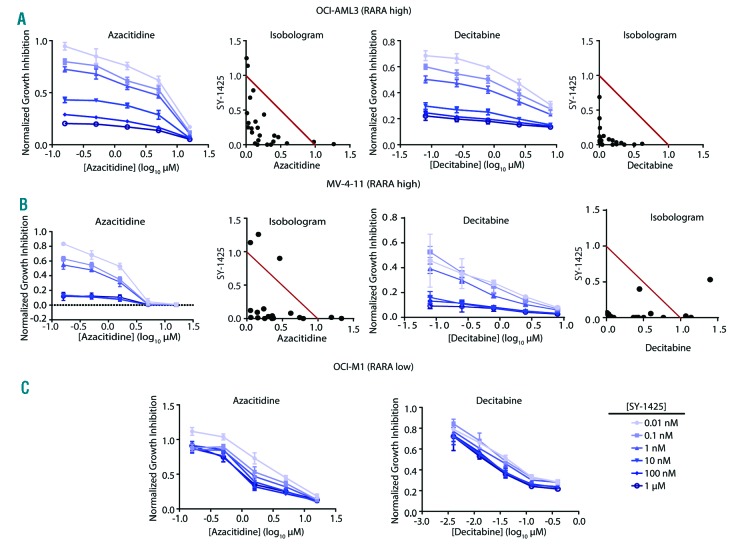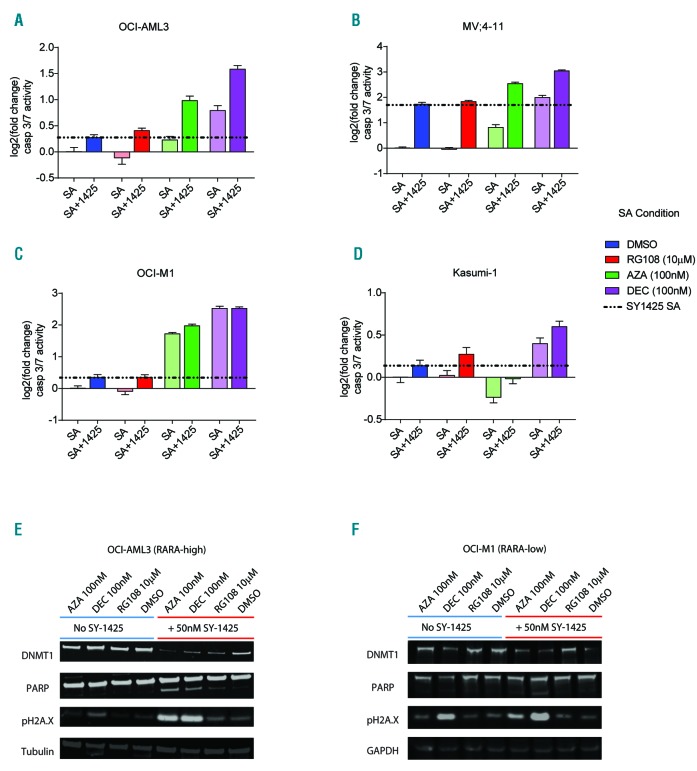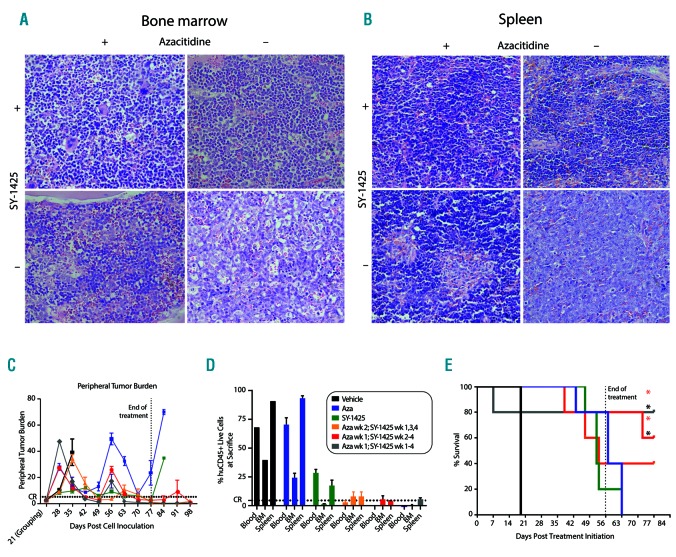Acute myeloid leukemia (AML) and biologically related myelodysplastic syndrome (MDS)1 are hematologic malignancies with poor outcomes. While recent approvals of new targeted therapies have increased options for some patients, those unfit for intensive treatment have few options,2–4 with single agent hypomethylating agents (HMAs) remaining as standard of care.1,5,6 The retinoic acid receptor alpha (RARα) transcription factor, encoded by the RARA gene, plays a critical role in myeloid cells and shows dysregulation in a subset of AML and MDS tumors.7 We recently demonstrated that the selective RARα agonist SY-1425 (tamibarotene) had biologic and clinical activity in 43% of evaluable relapsed or refractory AML and higher-risk MDS patients with activation of the RARA pathway.8 In this study, we sought to determine whether HMAs and SY-1425 exerted synergistic antiproliferative effects in AML models of RARA pathway activation in vitro and in vivo. Addition of HMAs and SY-1425 to RARA-high or IRF8-high, but not RARA-low, AML cell lines resulted in synergistic antiproliferative effects supported by evidence of DNA damage and apoptosis to a far greater extent than either agent alone. Studies in a patient-derived xenograft mouse model also demonstrated deeper and more durable responses with the combination than either agent alone. Furthermore, preclinical testing of various regimens determined that treating with azacitidine for one week followed by treatment with SY-1425 for three weeks maximized tumor suppression and tolerability. These findings directly support the ongoing clinical study of SY-1425 in combination with azacitidine.8
Both AML and MDS arise, in part, due to genetic alterations in transcription factors (i.e., RUNX1, NPM1) and epigenetic modifying genes (i.e., MLL, DNMT3A) leading to inactivation of tumor suppressor genes, thus enabling proliferation of immature cells.3 Alterations in DNA methyltransferases (DNMTs) specifically result in DNA hypermethylation which contributes to gene silencing through promoter inactivation, and can be targeted by HMAs that mimic native nucleoside residues and incorporate into DNA. Once incorporated, HMAs are recognized by DNMT1 as a cytosine, however this interaction creates an irreversible DNA-DNMT1 adduct that requires DNA damage repair to resolve. This then results in loss of DNMT1, as the DNA-protein adduct is degraded by the DNA damage response pathway.9 After loss of DNMT1, the cell cannot maintain its methylation enabling re-initiation of cellular differentiation pathways and induction of proliferative arrest.5,9,10
We recently demonstrated that super-enhancer (SE) analysis can define novel epigenomic subtypes of non-APL AML. In non-APL AML, RARA pathway activation, detected by the presence of SEs at the RARA or IRF8 gene loci, was found to be predictive of response to SY-1425 in preclinical models, establishing the potential for biomarker-guided clinical studies.7,11 SY-1425 (tamibarotene) is a selective and potent agonist for the nuclear hormone receptor RARα, with improved pharmacological properties over first-generation pan-retinoids such as ATRA.7 Tamibarone is currently approved in Japan for the treatment of patients with relapsed/refractory APL.7,12 Since both SY-1425 and HMAs have demonstrated roles in treating myeloid malignancies, operate on the gene regulatory level, and have non-overlapping toxicities, we hypothesized that their combination could show synergistic therapeutic potential.
To examine whether there is synergistic anti-proliferative activity between HMAs and SY-1425, we explored the combination of either azacitidine or decitabine with SY-1425 in RARA-high, IRF8-high, and RARA-low AML cell lines (Figure 1, Online Supplementary Figure S1). Increasing concentrations of SY-1425 showed synergistic anti-proliferative effects in combination with either azacitidine or decitabine in RARA-high and IRF8-high AML cell lines as shown by the growth curves and combination isobolograms (Figures 1A, 1B, Online Supplementary Figure S1A, S1B). Synergy was noted over a wide range of concentrations supportive of potential for pharmacologic interaction across clinically relevant ranges. The RARA/IRF8-low cell lines, OCI-M1, and KG1a, did not show a synergistic interaction despite sensitivity to HMAs alone, as shown in Figure 1C (Figure 1C, Online Supplementary Figure S1C). This supports the exploration of the combination for enhanced anti-tumor activity in RARA pathway biomarker-positive tumors.
Figure 1.
SY-1425 and hypomethylating agents had synergistic antiproliferative activity in RARA-high and IRF8-high cells. SY-1425 was added in increasing concentrations in combination with either azacitidine or decitabine in RARA-high (A) OCI-AML3, or (B) MV;4-11, or (C) RARA-low OCI-M1. Cellular growth inhibition was determined using ATPlite as a calculation of fold change in signal in compound treated wells over vehicle (Dimethyl Sulfoxide or DMSO) treated wells. Isobolograms illustrate the degree of synergy in reducing cell proliferation, where data points below the 1:1 line are synergistic, data points at or near the line are additive, and data points > 1 are antagonistic. An isobologram for the RARA-low cell line (C) could not be calculated since there was no meaningful dose effect of SY-1425 in combination despite HMA activity. A marked decrease in cell viability was seen with increasing amounts of SY-1425 in RARA-high, but which is not strongly seen in the RARA-low, cell line. Data shown is representative of results of three separate experiments.
The strong reduction in cell number seen with the combination in vitro supported the potential for induction of cell death. To characterize the combination relationship with cell death, we treated the RARA-high cell lines (OCI-AML3, MV;4-11, and SigM5) with azacitidine or decitabine for 24 hours, followed by SY-1425 for 24 hours (Figure 2A, 2B, Online Supplementary Figure S2A). In all cases, treatment with single agent alone led to low levels of induction of apoptosis as evidenced by caspase 3/7 activation, but the combination of SY-1425 and azacitidine led to significantly higher levels of apoptosis. However, the degree of response to the combination was dependent on the relative RARA expression and sensitivity to SY-1425. RARA high cells OCI-AML3 and MV;4-11 each had increases in apoptosis of log2(FC)>0.5 in the combination (SY1425+Aza or SY-1425+Dec) over single agents. By comparison, the RARA-low cells Kasumi-1 and OCI-M1 both had weaker enhancement of apoptosis in the combination, as measured by log2(FC)<0.5, over the single agents (Figure 2C, 2D, Online Supplementary Figure 2E). Intriguingly, pretreatment with RG108, a mechanistically distinct DNMT inhibitor that is non-covalent and non-DNA integrating,13,14 did not lead to the same degree of apoptosis when combined with SY-1425, indicating that the mechanism for induction of apoptosis may rely on the unique way that azacitidine and decitabine function through DNA incorporation and DNMT1 covalent trapping (Figures 2A–2D).
Figure 2.
Combination of SY-1425 and hypomethylating agents result in apoptosis and DNA damage in RARA-high and IRF8-high cells. Induction of apoptosis was measured via increase in caspase 3/7 with Promega™ Caspase-Glo® 3/7 Assay Systems in RARA-high AML cell lines (A) OCI-AML3 and (B) MV;4-11 as well as (C) RARA-low AML cell OCI-M1 and (D) Kasumi-1 pretreated with either DMSO, azacitidine, decitabine, or RG108 for 24 hours, followed by 24 Hours with SY-1425. There was a statistically significant increase in apoptosis induction (P<0.001 as measured by a two-tailed t-test) in cells treated with combination versus either SY-1425 alone or HMA alone, where the degree of response was related to the RARA expression. Upon addition of SY-1425 to cells treated with HMAs, DNA damage was detected via western blot based on induction of pH2A.X and PARP cleavage in (E) RARA-high OCI-AML3, and (F) RARA-low OCI-M1 AML cell lines. OCI-AML3 showed synergistic increase in pH2A.x only in the combination of azacitidine or decitabine with SY-1425 but not with RG108. Contrastingly, OCI-M1 show high pH2A.X with treatment of azacitidine or decitabine alone, which was only slightly increased when combined with SY-1425. Data shown is representative of results of three separate experiments. AZA: Azacitidine; DEC: Decitabine; SA: Single Agent.
Since both agents are directed to DNA interacting targets, we hypothesized that the source of cell killing could potentially originate from DNA damage. Indeed, the combination of SY-1425 with azacitidine or decitabine in RARA-high (OCI-AML3, MV;4-11, and SigM5) or IRF8-high (NOMO-1) cells resulted in induction of DNA damage as detected by PARP cleavage and phosphorylation of H2A.X, beyond that seen by HMA treatment alone (Figure 2E, Online Supplementary Figure S2B-2D). The RARA-low cell lines OCI-M1 and Kasumi-1 showed high levels of pH2A.X with HMA treatment alone, but little enhanced pH2A.X in the combination with SY-1425 (Figure 2F). Additionally, RG108 did not result in enhanced pH2A.X in the combination in any of the cell lines. This further supports that the DNA incorporation and covalent trapping of DNMT1 that occur with azacitidine and decitabine is needed for apoptosis induction (Figure 2E, 2F and Online Supplementary Figure S2B).13
The combination could alternatively boost re-initiation of terminal differentiation through HMA mediated hypomethylation, priming RARα target genes for enhanced SY-1425 mediated activation. To explore this, we examined gene expression changes in MV;4-11 (RARA-high AML cells) to determine if any genes were significantly enhanced in the combination versus the single agents. Overall, there were minor differences in expression changes driven by SY-1425 single agent compared to the combination (Online Supplementary Figure S2C). However, certain key macrophage lineage genes such as ITGAX (CD11c) and ITGAM (CD11b), showed a slight increase in expression level between SY-1425 single agent and the combination (log2 fold-change 0.59 and 0.32 respectively, FDR<0.01, Online Supplemental Figure S2D). However, given that these genes already showed a large enhacement with SY-1425 alone, the slight increase in the combination is likely not enough to explain the in vivo response.
To further support the rationale for clinical investigation of the combination, SY-1425 and azacitidine were administered to a disseminated patient-derived xenograft (PDX) mouse model of RARA-high AML. An initial study assessing pharmacodynamics (design schematic Online Supplementary Figure S3A) found that while single agent administration resulted in stable disease over a five-week course of treatment, only the combination resulted in regressions of tumors to undetectable levels, as assessed by quantification of human CD45+ cells in peripheral blood (PB). This deeper response also led to greater duration of response after treatment cessation compared with single agent administration (Online Supplementary Figure S3B). Tumor burden was further examined in the spleen (SP) and bone marrow (BM) of mice from each treatment group (Figure 3A-B). Based on morphology, there was a marked reduction in poorly differentiated blast cells in tissues following the combination treatment, including morphologic evidence of increased mature myeloid cells at 2 weeks, as compared to either agent alone.
Figure 3.
Patient-derived AML xenograft models showed increased sensitivity to SY-1425 and HMA combination. Mice were inoculated with human tumor cells followed by initiation of treatment 20 days later when peripheral huCD45+ cells reached ~5%. Representative images from spleen and bone marrow from initial pharmacodynamic study. (A) Bone marrow (%huCD45 Cells: Vehicle: 29.3%, Aza: 12.8%, SY-1425: 12.7%, Aza+SY-1425:5.3%) and (B) spleen (%huCD45 Cells: Vehicle: 63.1%, Aza: 14.9%, SY-1425: 22.5%, Aza+SY-1425:19.5%) samples were sectioned and stained with H&E to characterize the cellular morphology. Numbers shown represent percentage of huCD45+ cells in respective condition as determined through FACS analysis of cell dispersion. Follow-up regimen study had two cycles of treatment for each group. The following treatment cycles were used for the six groups of mice (N=5 per group): vehicle only; azacitidine alone for one week followed by no treatment for three weeks; SY-1425 alone for four weeks; SY-1425 alone for one week followed by azacitidine alone for one week, followed by SY-1425 alone for two weeks; azacitidine alone for one week followed by SY-1425 alone for three weeks; SY-1425 and azacitidine for one week followed by SY-1425 alone for three weeks. (C) The percentage of human CD45+ cells in peripheral blood was assayed by FACS weekly to determine peripheral tumor burden in each treatment group. Arms terminated when all mice on arm had died. (D) The percentage huCD45+ cells in peripheral blood, bone marrow, and spleen was assayed by FACS at time of termination for tissues to determine tumor burden reduction. Data is reflected of tissue harvested at termination as determined by humane endpoint. (E) Survival curves for the six treatment groups. Both groups where Aza was given in the first week (red and gray curves) had a significant (P<0.05 Mantel-Cox test) increase in survival over either SY-1425 (red*) or Aza (black*) alone. In (C) &(E), the vertical dashed line indicates the end of treatment for all arms, and the horizontal dashed line indicates a tissue burden decreasing to < 5%. Aza: azacitidine; BID: twice a day; BM: bone marrow; huCD45+: human CD45+; IP: intraperitoneal; PO: orally; QD: once a day; wk: week.
Using the same PDX model, we sought to optimize the regimen in an expanded study by comparing vehicle to single agents, or combinations, varying the first two weeks of a cycle (design schematic Online Supplementary Figure S4A). Mice treated with either single agent showed stable disease in peripheral blood measurements while on treatment and some survival benefit over vehicle (Figure 3C, 3D). The combination of SY-1425 with azacitidine showed a decrease of peripheral tumor burden over vehicle and sustained reduction post cessation of treatment over single agents (Figure 3C) irrespective of the regimen chosen. Furthermore, there was reduction of disseminated tumor in tissues at end of treatment (Figure 3D) when compared between combination and vehicle (P<0.05 in PB, BM, SP) or single agents (azacitidine: P<0.05 in PB, BM, SP; SY-1425: P<0.05 PB, SP). However, only when azacitidine was given in the first week (either alone for 7 days or concomitantly with SY-1425) did we see a significant (P<0.05) benefit in survival over single agent treatment (Figure 3E). This observation aligns with the proposed mechanistic models wherein hypomethylation and DNMT1 cross linking primes cells before SY-1425 activates transcription through RARα, thus allowing optimal induction of apoptosis seen in the combination. In addition, while concomitant administration resulted in some weight loss, the staggered treatment arm demonstrated stable mouse weight (Online Supplementary Figure S4B), suggesting reasonable tolerability. Both HMAs (in AML and MDS) and SY-1425 (tamibarotene in APL) are generally well tolerated with non-overlapping side-effect profiles in their approved indications, supporting a potentially useful therapeutic combination strategy.
The results of our in vitro and in vivo studies provide a strong mechanistically-guided rationale for combining SY-1425 and HMAs in the clinical setting in patients with AML and RARA pathway activation (hypothetical model Online Supplementary Figure S5). Our evidence suggests the combination may work via DNMT1 inactivation by HMA covalent cross-linking to DNA, causing DNA strain and damage when combined with strong target gene induction by SY-1425 at genes in AML that were previously shown to maintain a hypermethylated state. The importance of the cross-linking mechanism is further supported by the increased DNA damage observed with azacitdine/decitabine compared to the competitive inhibitor RG108. The single agents showed modest growth-arrest-driven effects in vivo, while the combination led to a strong reduction in tumor burden to nearly undetectable levels, and < 5% in tissues. This supports the cell-killing effect of the combination that was characterized in vitro as DNA damage and apoptosis. The safety and efficacy of SY-1425 in combination with azacitidine, as supported by these data, are currently being explored in a phase 2 trial in genomically defined subsets of patients with AML (clinicaltrials.gov identifier 02807558).7,15
Supplementary Material
Acknowledgments
Medical editorial assistance was provided by Samantha Falk, PhD, (ScientificPathways, Inc), with funding from Syros Pharmaceuticals, Inc.
Footnotes
Information on authorship, contributions, and financial & other disclosures was provided by the authors and is available with the online version of this article at www.haematologica.org.
References
- 1.Greenberg PL, Stone RM, Bejar R, et al. Myelodysplastic syndromes, Version 2.2015. J Natl Compr Cancer Netw. 2015;13(3):261–272. [DOI] [PMC free article] [PubMed] [Google Scholar]
- 2.Wang H-I, Aas E, Howell D, et al. Long-term medical costs and life expectancy of acute myeloid leukemia: a probabilistic decision model. Value Health. 2014;17(2):205–214. [DOI] [PubMed] [Google Scholar]
- 3.Papaemmanuil E, Gerstung M, Bullinger L, et al. Genomic classification and prognosis in acute myeloid leukemia. N Engl J Med. 2016;374(23):2209–2221. [DOI] [PMC free article] [PubMed] [Google Scholar]
- 4.Wang ES. Treating acute myeloid leukemia in older adults. Hematology Am Soc Hematol Educ Program. 2014;2014(1):14–20. [DOI] [PubMed] [Google Scholar]
- 5.Yun S, Vincelette ND, Abraham I, Robertson KD, Fernandez-Zapico ME, Patnaik MM. Targeting epigenetic pathways in acute myeloid leukemia and myelodysplastic syndrome: a systematic review of hypomethylating agents trials. Clin Epigenetics. 2016;8:68. [DOI] [PMC free article] [PubMed] [Google Scholar]
- 6.Koh Y, Kim YA, Kim K, et al. Decitabine is superior to cytotoxic chemotherapy in elderly acute myeloid leukemia patients in terms of medical source utilization and cost-effectiveness without negatively impacting survival outcomes. Blood. 2016;128(22):2381.27707735 [Google Scholar]
- 7.McKeown MR, Corces MR, Eaton ML, et al. Superenhancer analysis defines novel epigenomic subtypes of non-APL AML, including an RARα dependency targetable by SY-1425, a potent and selective RARα agonist. Cancer Discov. 2017;7(10):1136–1153. [DOI] [PMC free article] [PubMed] [Google Scholar]
- 8.Jurcic JG, Raza A, Vlad G, et al. Early results from a biomarker-directed phase 2 trial of Sy-1425 in acute myeloid leukemia (AML) and myelodysplastic syndrome (MDS) demonstrate DHRS3 Induction and myeloid differentiation following Sy-1425 treatment. Blood. 2017;130(Suppl 1):2633. [Google Scholar]
- 9.Sato T, Issa JJ, Kropf P. DNA hypomethylating drugs in cancer therapy. Cold Spring Harb Perspect Med. 2017;7(5). [DOI] [PMC free article] [PubMed] [Google Scholar]
- 10.Lemaire M, Chabot GG, Raynal NJ, et al. Importance of dose-schedule of 5-aza-2’-deoxycytidine for epigenetic therapy of cancer. BMC Cancer. 2008;8:128. [DOI] [PMC free article] [PubMed] [Google Scholar]
- 11.Hashimoto Y, Kagechika H, Kawachi E, Shudo K. Specific uptake of retinoids into human promyelocytic leukemia cells HL–60 by retinoid–specific binding protein: possibly the true retinoid receptor. Jpn J Cancer Res. 1988;79(4):473–483. [DOI] [PMC free article] [PubMed] [Google Scholar]
- 12.Miwako I, Kagechika H. Tamibarotene. Drugs Today (Barc). 2007;43(8):563–568. [DOI] [PubMed] [Google Scholar]
- 13.Brueckner B, Garcia Boy R, Siedlecki P, et al. Epigenetic reactivation of tumor suppressor genes by a novel small-molecule inhibitor of human DNA methyltransferases. Cancer Res. 2005;65(14):6305–6311. [DOI] [PubMed] [Google Scholar]
- 14.Stresemann C, Brueckner B, Musch T, Stopper H, Lyko F. Functional diversity of DNA methyltransferase inhibitors in human cancer cell lines. Cancer Res. 2006;66(5):2794–2800. [DOI] [PubMed] [Google Scholar]
- 15.A biomarker-directed phase 2 trial of SY-1425 in patients with acute myeloid leukemia or myelodysplastic syndrome. https://clinicaltri-als.gov/ct2/show/NCT02807558 (2017).
Associated Data
This section collects any data citations, data availability statements, or supplementary materials included in this article.





